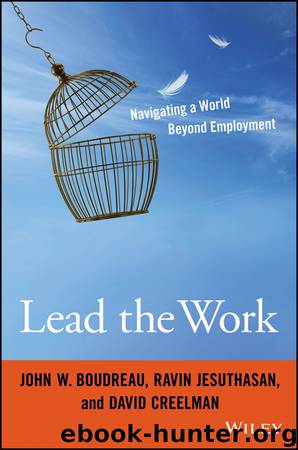Lead the Work by Jesuthasan Ravin Creelman David Boudreau John W. & Ravin Jesuthasan & David Creelman

Author:Jesuthasan, Ravin, Creelman, David, Boudreau, John W. & Ravin Jesuthasan & David Creelman
Language: eng
Format: epub
ISBN: 9781119040071
Publisher: Wiley
Published: 2015-08-03T00:00:00+00:00
Chapter 8
The New Organization: Permeable, Interlinked, Collaborative, and Flexible
Let's see how our framework and some of the “new age” ideas could play out in a fairly staid and conservative sector. The core of the insurance industry has traditionally been about risk evaluation and mitigation. This remains the case today. At the same time, though, technology is transforming this industry, for example by enhancing their ability to manage risk and capital. In addition, their customers have benefited from greater choice and more transparent pricing. More recently, we have seen social media and big data transform other industries, and insurance cannot be far behind.
These new technologies can offer valuable insights into customer needs, buying behavior, underwriting risks, and pricing strategies. If insurers are slow to react, new, technologically savvy competitors are likely to enter the insurance space.
To capitalize on these new technologies insurance companies are changing the way they operate. Some are embracing cloud-based computing, others are introducing new products such as usage-based insurance, and many are experimenting with social media. Underlying all of these initiatives is the need for a more diverse and technology-savvy workforce. Combine this need with the fact that the insurance industry is characterized by a fairly mature workforce—about 25 percent of U.S. finance and insurance industry workers are 55 or older1—and you get an industry that is poised for change in its talent requirements.
Consider the challenge of attracting these technology-proficient employees. According to the Global Talent 2021 study, conducted by Oxford Economics and Towers Watson in 2012, talent shortages in key technical areas in developed countries will increase dramatically over the next 10 years. The issue is further complicated by the fact that insurers will be competing not only with other insurers but also with other industries for the same highly desirable human capital.
If insurers cannot attract sufficient technical talent as employees, what choices do they have? We think that at this point in the book you will be able to guess our answer. The choice is to move beyond employment and borrow the talent from elsewhere, perhaps through talent platforms, perhaps through alliances, perhaps through employee loans. The industry needs a new vision of what an organization is.
Download
This site does not store any files on its server. We only index and link to content provided by other sites. Please contact the content providers to delete copyright contents if any and email us, we'll remove relevant links or contents immediately.
| Conflict Resolution & Mediation | Human Resources & Personnel Management |
| Knowledge Capital | Outsourcing |
Bullshit Jobs by David Graeber(4094)
Radical Candor by Kim Scott(2668)
I Am Right, You Are Wrong by Edward De Bono(2420)
23:27 by H. L. Roberts(2195)
Nomadland by Jessica Bruder(2014)
Average Is Over by Tyler Cowen(1805)
The Conflict Resolution Phrase Book by Barbara Mitchell & Cornelia Gamlem(1734)
Out of Our Minds: Learning to Be Creative by Ken Robinson(1691)
High-Impact Interview Questions by Victoria A. Hoevemeyer(1663)
Who Moved My Cheese?: An Amazing Way to Deal With Change in Your Work and in Your Life by Johnson Spencer(1615)
The Ideal Team Player by Patrick M. Lencioni(1608)
An Everyone Culture: Becoming a Deliberately Developmental Organization by Robert Kegan & Lisa Laskow Lahey(1599)
The Asshole Survival Guide by Robert I. Sutton(1559)
Automatic Society by Bernard Stiegler(1511)
Unleashed by Anne Morriss & Frances Frei(1492)
Who by Street Randy & Smart Geoff(1471)
42 Rules of Employee Engagement by Susan Stamm(1438)
96 Great Interview Questions to Ask Before You Hire by Paul Falcone(1400)
Fish! by Stephen C. Lundin(1346)
